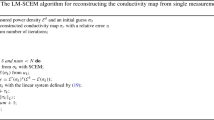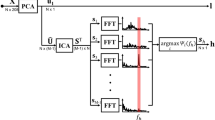Abstract
The main aim of the study is to establish a relation between different sources of Impedance cardiogram (ICG) as function of spatial distribution of conductivity. A three-dimensional model of a human thorax using the finite element method has been constructed. The model includes 35 horizontal layers consisting of up to 519 pentahedral elements that are automatically divided into tetrahedral ones before calculating the potential distribution. Electrode array configuration proposed by Kubicek et al. (Aerosp. Med. 37: 1208–1212, 1996) has been studied. A relationship proposed by Geselowitz (IEEE Trans. Biomed. Eng. 18: 38–41, 1971) has been used to calculate the sensitivity of the examined electrode array to conductivity changes inside the thorax. This relationship has allowed for the calculation of the contributions to ICG from spatially separated sources when modeling all changes in conductivity simultaneously. It has been confirmed that the main contributions to ICG signal come from ventricles, atria, aorta, and lungs. The relations between these components have been found to be dependent nonlinearly on spatial conductivity distribution. As a result, reliable and reproducible measurements of stroke volume (SV) using ICG are impossible. Nevertheless, ICG can be used to monitor relative changes of SV in all cases where the spatial distribution of conductivity and geometry of the subject, during the examination, is preserved. However, it does not mean that the accuracy of SV measurement will be the same in all these cases. © 2000 Biomedical Engineering Society.
PAC00: 8719Hh, 8719Nn, 8437+q, 0270Dh
Similar content being viewed by others
REFERENCES
Bernstein, D. P. A new stroke volume equation for thoracic electrical bioimpedance: theory and rationale. Crit. Care Med. 14:904-909, 1986.
Bochenek, A., and M. Reicher. Human Anatomy. (in Polish). Warsaw: PZWL, 1960.
Epstein, B. R., and K. R. Foster. Anisotropy in the dielectric properties of skeletal muscle. Med. Biol. Eng. Comput. 21:51-55, 1983.
Geddes, L. A., and L. E. Baker. The specific resistance of biological material-a compendium of data for the biomedical engineer and physiologist. Med. Biol. Eng. 5:271-293, 1967.
Geselowitz, D. B. An application of electrocardiographic lead theory to impedance plethysmography. IEEE Trans. Biomed. Eng. 18:38-41, 1971.
Henriquez, C. S. Simulating the electrical behavior of cardiac tissue using the bidomain model. Crit. Rev. Biomed. Eng. 21:1-77, 1993.
Ito, H., K.-I. Yamakoshi, and T. Togawa. A model study of stroke volume values calculated from impedance and their relation to the waveform of blood flow. IEEE Trans. Biomed. Eng. 24:489-91, 1977.
Jackson, J. D. Classical Electrodynamics. New York: Wiley, 1975.
Kauppinen, P. K., J. A. Hyttinen, and J. A. Malmivuo. Sensitivity distributions of impedance cardiography using band and spot electrodes analyzed by a three-dimensional computer model. Adv. Biomed. Eng. 26:694-702, 1998.
Kim, D. W., L. E. Baker, J. A. Pearce, and W. K. Kim. Origins of the impedance change in impedance cardiography by a three-dimensional Finite Element Model. IEEE Trans. Biomed. Eng. 35:993-1000, 1988.
Kubicek, W. G., J. R. Karnegis, R. P. Patterson, D. A. Witose, and R. H. Mattson. Development and evaluation of an impedance cardiographic system to measure cardiac output and other cardiac parameters. Aerosp. Med. 37:1208-1212, 1966.
Mohapatra, S. N. Noninvasive Cardiovascular Monitoring by Electrical Impedance Technique. London: Pitman Medical, 1981.
Patterson, R. P. Sources of the thoracic cardiogenic electrical impedance signal as determined by a model. Med. Biol. Eng. Comput. 23:411-417, 1985.
Patterson, R. P. Fundamentals of impedance cardiography. IEEE Eng. Med. Biol. Mag. 8:35-38, 1989.
Raaijmakers, E., Th. J. C. Faes, H. G. Goovaerts, P. M. J. M. de Vries, and R. M. Heethaar. The inaccuracy of Kubicek's one-cylinder model in thoracic impedance cardiography. IEEE Trans. Biomed. Eng. 44:70-76, 1997.
Reddy, G. N., and S. Saha. Electrical and dielectric properties of wet bone as a function of frequency. IEEE Trans. Biomed. Eng. 31:296-302, 1984.
Sakamoto, K., and H. Kanai. Electrical characteristics of flowing blood. IEEE Trans. Biomed. Eng. 26:685-695, 1979.
Sakamoto, K., K. Muto, H. Kanai, and M. Izuka. Problems of impedance cardiography. Med. Biol. Eng. Comput. 17:697-709, 1979.
Schwan, H. P., and S. Takashima. Dielectric behaviour of biological cells and membranes. Bull. Inst. Chem. Res., Kyoto Univ. 69:459-475, 1991.
Shankar, T. M. R., J. G. Webster, and S. Shao. The contribution of vessel volume change and blood resistivity change to the electrical impedance pulse. IEEE Trans. Biomed. Eng. 32:192-198, 1985.
Vision Human Project. Images available at zatoka. icm. edu. pl
Wang, L., and R. P. Patterson. Multiple source of the imped-ance cardiogram based on 3D finite difference human thorax models. IEEE Trans. Biomed. Eng. 42:141-148, 1995.
Witose, D. A., and E. Kinnen. Electrical resistivity of lung at 100 kHz. Med. Biol. Eng. 5:239-248, 1967.
Woltjer, H. H., B. W. G. J. Arntzen, H. J. Bogaard, and P. M. J. M. de Vries. Optimalisation of the spot electrode array in impedance cardiography. Med. Biol. Eng. Comput. 34:84-87, 1996.
Woo, E. J., P. Hua, J. G. Webster, and W. J. Tompkins. Measuring lung resistivity using electrical impedance tomography. IEEE Trans. Biomed. Eng. 39:756-760, 1992.
Wtorek, J., and A. Poliñski. Examination of impedance cardiography properties-FEM model studies. Biomedical Sci-ences Instrumentation 31:77-82, 1995.
Wtorek, J., A. Polinski, J. Stelter, and A. Nowakowski. Cell for measurements of biological tissue complex conductivity. Technology and Health Care.6:177-193, 1998.
Wtorek, J., and A. Polinski. Modelling of changes in blood complex permittivity contributions to impedance signal. In: Proc. of 10th Int. Conf. Electrical Bio-Impedance, Barcelona, Spain, 1998, pp. 109-112.
Yamakoshi, K.-I., H. Shimazu, T. Togawa, and H. Ito. Admittance plethysmography for accurate measurement of human limb blood flow. Am. J. Physiol. 235:H821-H829, 1978.
Zheng, E., S. Shao, and J. G. Webster. Impedance of skeletal muscle from 1 Hz to 1 MHz. IEEE Trans. Biomed. Eng. 31:477-481, 1984.
Author information
Authors and Affiliations
Rights and permissions
About this article
Cite this article
Wtorek, J. Relations Between Components of Impedance Cardiogram Analyzed by Means of Finite Element Model and Sensitivity Theorem. Annals of Biomedical Engineering 28, 1352–1361 (2000). https://doi.org/10.1114/1.1327596
Issue Date:
DOI: https://doi.org/10.1114/1.1327596




